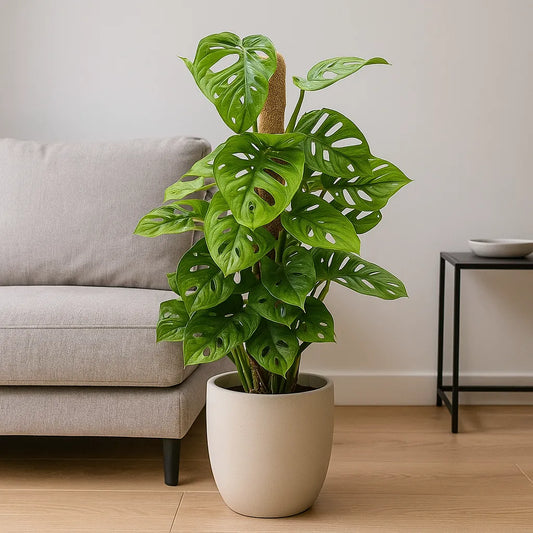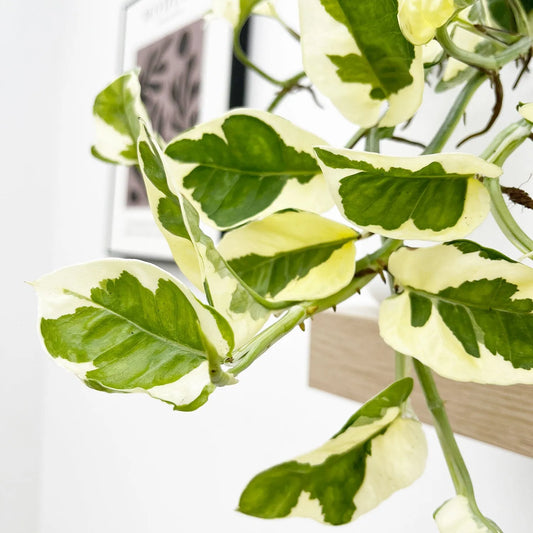Calathea with Yellow Leaves: What is the Problem?
One of the best things about owning a Calathea is that they make it really easy to identify if there is a problem. One of the more obvious signs that something is wrong with your Calathea is when the leaves begin to go yellow. So, why are your Calathea leaves going yellow? In this guide we will take you through the most common reasons this happens and how to fix any problems.
Overwatering
The most common reason for yellowing Calathea leaves is overwatering. This tropical houseplant species is really sensitive to moisture levels in the soil and overwatering can lead to root rot and fungal growth that can stop the plant taking in all the nutrients it needs. This causes the leaves to start turning yellow at the edges. This discolouration will spread until the leaf dies.
The Calathea likes consistently moist soil that is not too wet. The best way to tell if your soil is too wet is to test the top few centimeters of soil with your finger, if it is dry, it’s time to water. You should also make sure that the pot has enough drainage holes to allow any excess water to drain from the pot.
Dry Soil
The Calathea walks a fine line between soil that is too wet and too dry. Dry soil can cause the Calathea to become stressed, and this stress presents itself as yellow leaves that take on a papery texture.
The most common reason that people end up with dry Calathea soil is because they stick to a defined watering schedule. As the year goes on and temperatures rise in the summer you will need to water your plant more often as your Calathea becomes more active and absorbs more water at the same time more water is evaporating. You need to make sure you are regularly checking your soil to see how dry it is and adjust your watering to match.
Low Humidity
Like all tropical plants, the Calathea relies on ambient humidity to take in a large percentage of its moisture. Since the plant cannot take in all of its moisture through the roots alone if it is a less humid environment the foliage will become dry and begin to yellow.
When you first see the leaves beginning to yellow and dry out you should check the soil to see if it's too dry or not. If it is fine then it is likely the humidity that is the problem. There are a few ways to fix a Calathea that isn’t receiving enough humidity:
Misting the leaves - the easiest way to make a short-term difference in your plants humidity is to regularly mist the leaves with a spray bottle. This applies moisture directly to the leaves and you will see an almost immediate change in the leaves. This a short-term solution and won’t affect the overall humidity of the room, but is a good option if you can keep up with the misting.
Pebble or water trays - placing your plant pot on a pebble or water tray will naturally increase the humidity in the area around it. The change in humidity will be small but in most cases will be enough to keep your Calathea happy and vibrant.
Room humidifier - If you want to take things to the next level and create the best environment for your Calathea then your best option is to introduce a humidifier to your room. This will improve the overall humidity of the room, creating a wonderful environment for all tropical houseplants.
Grouping plants - Calathea plants are an ideal choice for being a centerpiece of a tropical plant display. The soil of all these plants when grouped together will increase the overall humidity in the space which will improve the look and feel of all the plants in your space.
Incorrect lighting
The leaves of the Calathea are sensitive to changes in light conditions and over or under exposure to light can cause a yellowing of the leaves.
Low lighting - Calatheas thrive in around eight hours of bright, indirect light a day. If your plant is receiving much less than that then you should either move it to a new, sunnier location or consider putting a grow light in place.
Too much light - whilst Calathea plants love bright light, it needs to be ambient light. In the wild, Calathea plants grow under the canopies of taller plants and have adapted to these conditions. Strong direct sunlight can cause sunburn to your plants foliage which will eventually cause the leaf to die and stop the plant creating energy. The solution to this is simple, you can either move your plant further away from the light source or to cover that light source to filter the light slightly.
Changes in conditions
Like a lot of tropical houseplants, Calathea can be fussy when their conditions change. You will often find that your Calathea goes into shock when you first bring it home or move it to a new location. In these cases the leaves will yellow slightly all over, but will otherwise stay the same. Water the plant well and leave for a week to see if the leaves clear up. If they don’t check for any of the signs and symptoms on the rest of this list as your new location may need some adjustment.
Temperature changes
Calathea plants should be kept in temperatures between 16ºC and 27°C to keep them in the best condition. You should try your best to keep the plant within this range since any dips oor rises above it can be damaging to your plant even after a short amount of time. You can tell if your Calathea is too hot or too cold by looking at the leaves. They will begin to turn yellow, but unlike some of the other conditions described in this list the yellow be of a more sickly color.
Sorting out this issue is easy, make sure you plant is away from radiators or cold draughts in the first instance. If the problem persists, you should consider buying a thermometer to put in your plant pot to keep a closer eye on things. Also take note that the setting on your thermostat may not be the actual temperature in parts of your room.










